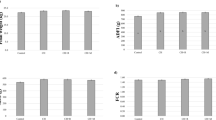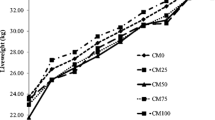Abstract
The objective of this study was to determine the impact of including licuri cake in the diet of Santa Inês crossbred finishing lambs by examining their liver metabolic and histopathological profile. Forty-four uncastrated lambs with an average age of 6 months and an average weight of 21.2 kg ± 2.7 kg. The animals were fed diets with 40 % Tifton 85 hay and 60 % of a mixture consisting of corn and soybean meal, 1 % urea, a mineral-vitamin premix, and an inclusion of licuri cake at a level of 0, 8, 16, and 24 % of the dietary dry matter (DM), which composed the treatments. The experimental design was completely randomized, and the data were analyzed by variance and regression analyses. The animals were confined in individual stalls for 70 days. Blood was collected on the last day of the experimental period, and metabolite, protein, energy, and enzyme profiles of the liver were determined for these samples. Histopathological evaluations of the liver parenchyma were also undertaken. The increase in the level of the licuri cake in the diet caused a linear increase (P < 0.05) in the serum urea content. The protein metabolism was not affected by the licuri cake inclusion levels in the diet. Regarding energy metabolism, a linear increase (P < 0.01) was observed in the serum triglyceride concentrations, but there were no effects on serum cholesterol levels. Regarding the functioning of the liver and muscle, the inclusion of the licuri cake had no effect on the enzymatic activities, except on gamma-glutamyltransferase, which decreased linearly (P < 0.05). The values found for the evaluated parameters varied within a range considered normal for this species. In the postmortem examination at slaughter, no macroscopic alterations in the liver were observed. Histopathological analysis revealed the presence of discrete and nonspecific alterations common to all treatments, suggesting no effect of the level of inclusion of the licuri cake. The use of the licuri cake in composing up to 24 % of the diet did not cause metabolic or liver disorders in the lambs.
Similar content being viewed by others
References
Andrade-Montemayor, H.; Gasca, T. G.; Kawas, J. 2009. Ruminal fermentation modification of protein and carbohydrate by means of roasted and estimation of microbial protein synthesis. Revista Brasileira de Zootecnia. 38, 277–291.
AOAC—Association of Official Analytical Chemistry. 1990. Official methods of analysis of the Association of Official Analytical Chemists. 15th edition. Washington.
Araújo, M.L.; Carvalho, G.G.P.; Ayres. M.C.C.; Bezerra; L.S., Rebouças, R.A.; Filho, C.H.C.V.; Oliveira, R.L.; Silva, T.M.; Leite, J.K.C.; Teixeira, C.C.K. 2014. Assessment of the metabolic, protein, energy, andliver profiles of lambs finished in a feedlot and receiving diets containing groundnut cake.Tropical Animal Health Production. 46, 433–437.
Bach, A.; Calsamiglia, S.; Srern, M. D. 2005. Nitrogen metabolism in the rumen. Journal of Dairy Science. 88(E- Suppl.) 9–21.
Bacila, M. Bioquímica Veterinária. 2nd edn. São Paulo, Robe, 2003.
Bezerra, L. R.; Ferreira, A. F.; Camboim, E. K. A.; Justiniano, S. V.; Machado, P. C. R.; Gomes, B. B. 2008. Profile hematological of goat clinical healthy servants in Caririparaibano. Ciência e Agrotecnologia. 32, 950–960.
Bonfim, M. A. D.; Silva, M. M. C.; Santos, S. F. 2007. Potentialities of the use of by-products of the biodiesel industry in the feeding of goats and sheep. In: 3 Simpósio Internacional Sobre caprinos e Ovinos De Corte-SINCORTE.João Pessoa, Paraíba, Brasil. 1–21.
Borja, M. S.; Oliveira, R. L.; Ribeiro, C. V. D. M.; Bagaldo, A. R.; Carvalho, G. G. C.; Silva, T. M.; Lima, L. S.; Barbosa, L. P. 2010. Effects of feeding licury (Syagrus coronate) cake to growing goats. Asian-Australasian Journal Animal Science. 23, 1436–1444.
Caldeira, R. M. 2005. Monitoring the adequacy of feeding plan and nutritional status in ewes. Revista Portuguesa de Ciências Veterinárias. 100, 125–139.
Carrera, R. A. B.; Veloso, C. M.; Knupp, L. S.; Júnior, A.H.S.; Detmann, E.; Lana, RP. 2012. Protein co-products and by-products of the biodiesel industry for ruminants feeding. Revista Brasileira de Zootecnia, 41, 1202–1211.
Coles, E. H. Veterinary Clinical Pathology. 5thedn. Philadelphia : W.B. Saunders, 1986.
Contreras, P.A.; Witter, F.; Bohmwald, H. 2000. Uso dos perfis metabólicos no monitoramento nutricional dos ovinos. In: Gonzalez, F.H.D.; Durr, J.W.; Fontaneli, R.S. (Eds.) Perfil metabólico em ruminantes: seu uso em nutrição e doenças nutricionais. Gráfica da Universidade Federal do Rio Grande do Sul, 75–88.
Costa, J. B. 2015. Torta de licuri na terminação de cordeiros. Tese de doutorado. Universidade Federal da Bahia, Pós-Graduação em Zootecnia, p 24.
David, D.B., Poli, C.H.E.C., Azevedo, E.B., Fernandes, M.A.M., Carvalho, P.C.F., Jochims, F.; Pimentel, C.M.M. 2012. Potential response to supplementation of ewe lambs grazing natural pastures over winter.Small Ruminant Research. 105, 22–28.
González, F.H.D.; Campos, R. 2003. Indicadores metabólicos nutricionais do leite. In: Gonzalez, F.H.D., Campos, R. (eds.): Anais do primeiro simpósio de patologia clinica veterinária da região sul do Brasil. Porto Alegre. Gráfica da Universidade Federal do Rio Grande do Sul. 31–47.
González F. H. D.; Silva S. C. 2006. Introdução a bioquímica clínica veterinária, 2ª edição. Editora daUniversidade Federal do Rio Grande do Sul. 357p.
González, F. H. D.; Barcellos, J.O.; Patiño. H.O.; Ribeiro. L. A. 2000. Perfil metabólico em ruminantes: seu uso em nutrição e doenças nutricionais. Gráfica Universidade Federal do Rio Grande do Sul. 108p.
Kelly, W. R. 1976. Diagnóstico ClínicoVeterinário. 2th edition México: Companhia Editorial Continental. 444 p.
Licitra, G.; Hernandez T. M.; Van Soest, P. J. 1996. Standardization of procedures for nitrogen fractionation of ruminant feeds. Animal Feed Science and Technology. 57, 347–358.
Luna, L.G. 1968. Manual of Histologic Staining Methods of the Armed Forces Institute of Pathology, 3th edition. McGraw-Hill, New York. 258p.
Marques, K. B. 2007. Metabolic profile of lambs under rangeland conditions fed different supplementation levels and in different environment conditions, in the semi-arid region of paraiba. Dissertação de Mestrado. Universidade Federal de Campina Grande, Centro de Saúde e Tecnologia Rural. 38p.
Meira Jr.; E. B. S.; Rizzo, H.; Benezi, F. J. 2009. Influence of and sex on total serum protein and albumin and aspartato-aminotransferase and gama-glutamiltransferase serum activities on Santa Inês Sheep. Brazilian Journal of Veterinary Research and Animal Science, São Paulo. 46, 448–454.
National Research Council. 2001. Nutrient requirements of dairy cattle.7th edition. Washington: National Academy Press. 381p.
Nicory, I.M.C.; Carvalho, G.G.P.; Ribeiro, O.L.; Souza, F.N.C.S.; Costa-Lopes, L.S.; Nascimento, C.O.; Teixeira, C.S.C.; Moraes, C.J. 2014. Hepatic parameters in lambs fed diets containing detoxified castor bean meal. In: 24 Congresso Brasileiro de Zootecnia-ZOOTEC.Vitória, Espirito Santo, Brasil.
Nunes, A. S.; Oliveira, R. L.; Ayres, M. C. C. 2010. Hepatic condition of lambs fed diets with palm kernel cake from biodiesel production. Revista Brasileira de Zootecnia. 39, 1825–1831.
Payne, J.M., Payne, S. 1987. The metabolic profile test. Oxford: Oxford University Press. 179p.
Peixoto, L. A. O.; Osório, M. T. M.; Osório, J. C. S.; Nornberg, J. L.; Pazzini, M. 2009. Metabolic Profile from Ile de France Sheep Fed with Organic or Common Salt on Breading Season. In: 46ªReunião Anual da Sociedade Brasileira de Zootecnia-SBZ. Maringá, Paraná, Brasil.
Pugh, D. C.; Dum, M. S. 2005. Clínica de ovinos e caprinos. São Paulo: Edições Roca. 1150p.
Rabassa, V. R.; Schwegler, E.; Goulart, M. A.; Lopes, M. S.; Hoffmann, D. A.; Lisboa, F. P.;Vendramin, L.; Roll, V. F. B.; Diaz, G. J.; Del Pino, F. A. B.; Corrêa, M. N. 2010. Metabolic parameters of ewes receiving diets containing aflatoxin and zearalenone with addition of modified glucomannan. Brazilian Journal of Veterinary Research and Animal Science. 47, 67–73.
Ramalho, C.I. 2008. Vegetation structure and spatial distribution of licuri (syagruscoronata (Mart.) Becc.) In two municipalities from the mid-northern bahia, brazil. Dissertção de Mestrado. Universidade Federal da Paraíba, Centro de Ciências Agrárias. 127p.
Rodrigues, M. R. C.; Rondina, D.; Araújo, A. A.; Arruda, I. J.; Silva, L. M.; Nunes-Pinheiro, D. C.; Fernandes, A. A. O. 2010. Use of Dehydrated Cashew Apple Pomace (Anacardium occidentale) the Feeding of Lambs Weaning Puberty: Metabolic Responses and Sex Hormone. Universidade Estadual do Ceará. Ciência Animal. 20, 17–26.
Rossi, C.A.R.; Filappi, A.R.; Prestes, D.S.; Noro, M.; Rossato, F.G.; Linston, M.A.; Abreu, C.; Costa, S.T.; Cecim, M. 2005. Hepatic functional insufficiency and fatty liver in sheep: protocol for experiment al induction. Pontifícia Universidade Católica do Rio Grande do Sul. Revista da FZVA.12, 123–134.
Santos, F. C. O.; Mendonça, C. L.; Silva Filho, A. P.; Carvalho, C.C.D.; Soares, P. C.; Afonso, J.A.B. 2011. Biochemical and hormonal indicators of natural cases of pregnancy toxaemia of in sheep. Brazilian Journal of Veterinary Research. 31, 974–980.
SAS Institute Inc. SAS OnlineDoc® 9.1.3. Cary, NC: SAS Institute Inc., 2014.
Tizard, I. R. 2000. Veterinary Immunology: an introduction. 6th edition. London: Saunders Company.482p.
Van Cleff, H. E.; Patino, P. R.; Neiva Jr, P. A.; Serafim, S. R.; Rêgo, C. A.; Gonçalves, S.J. 2009. Metabolic disorders due to improper han-dling of nutrition in Ruminants: new concepts, Revista Colombiana de Ciencia Animal. 1, 319–341.
Van Soest, P. J.; Robertson, J. B.; Lewis, B. A. 1991. Methods for dietary fiber, neutral detergent fiber, and nonstarch polysaccharides in relation to animal nutrition. Journal of Dairy Science. 74, 3583–3597.
Wittwer, F. 2012. Manual de PatologíaClinicaVetrinária. 2nd ed. Imprenta América. Valdívia, Chile. 200p.
Author information
Authors and Affiliations
Corresponding author
Ethics declarations
Conflict of interest
The authors declare that they have no competing interests.
Rights and permissions
About this article
Cite this article
Costa, J.B., Oliveira, R.L., Silva, T.M. et al. Liver metabolic and histopathological profile in finishing lambs fed licuri (Syagrus coronata(Mart.)Becc.) cake. Trop Anim Health Prod 48, 501–507 (2016). https://doi.org/10.1007/s11250-015-0981-6
Received:
Accepted:
Published:
Issue Date:
DOI: https://doi.org/10.1007/s11250-015-0981-6




